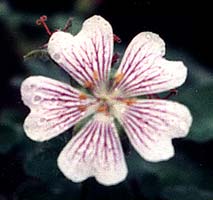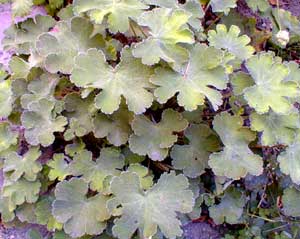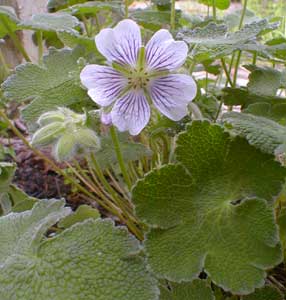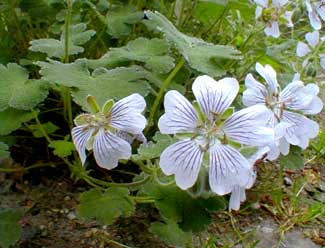 Renard's Hardy Geranium
Renard's Hardy Geranium
"The silver-blue moonlight
makes the geraniums purple,
and the roof glitters
like ice."
-Amy Lowell,
1874-1925
1874-1925
We originally planted the Renard's crane's-bill (Geranium renardii) at the foot of our Highbush Cranberry (Viburnum trilobum) right outside our back door, where it would get afternoon sun. But I began to worry about the soil being too rich for it there, & it was watered too often for this species.
 I moved it across the garden path to be near a Red Hot Poker or Torch Lily, where afternoon sun exposure was even better, but the soil had not been so greatly enriched & it was less often watered.
I moved it across the garden path to be near a Red Hot Poker or Torch Lily, where afternoon sun exposure was even better, but the soil had not been so greatly enriched & it was less often watered.It did much better in this location except that over time, alas, the torch lily got so gigantic it overwhelmed & completely stifled our tragically abused Renard. When it came time to divide the torch lily, I decided I might as well move it altogether, & it went in halves out on the street in a xeriscape garden.
Shortly after the torch lily was out of the Renard's crane's-bill way, the crane's-bill at long last leapt to life in the dryish sunny location, forming a gorgeous evenly mounded compact clump of felty leaves.
The second photo from August 2003 shows the unusually attractive leaves as they've been this year without flowers.
 Because it had been left so long to fend for itself with the domineering torch lily, it went for over a year not blooming.
Because it had been left so long to fend for itself with the domineering torch lily, it went for over a year not blooming. By Spring 2004 it was again in flower, better than ever, & it is not apt again to suffer the stresses initially imposed upon it for its first two years. The third photo shows it in April bud, with one bloom fully opened.
The usual bloom period is June & July, but ours bloomed (in 2001 & 2002) starting in May, & in 2004 it was blooming by mid-April. The flower detail at the top of the page was taken May 2001. The third & fourth photos are from April & May respectively, 2004.
The species comes in many cultivated colors, but ours is the natural form, such as became a recipient of the Royal Horticultural Society's coveted Award of Garden Merit. It produces flowers that are white with blush of blue, & with such fine deep violet lines on each petal that they seem to have been etched.
 It only grows to about one foot or 15 inches high, smaller than the majority of the cranebills, & does not sprawl much, but remains a tidy round clump.
It only grows to about one foot or 15 inches high, smaller than the majority of the cranebills, & does not sprawl much, but remains a tidy round clump.The grey-green foliage provides excellent texture to a garden even when not in flower. These leaves look quite different from those of other crane's-bills, in that they are thicker & vastly more pubescent.
The hairiest sorts of leaves in many genera tend to be for plants that want to be watered the least often, & Renard's is in keeping with this generality, in that it would do very poorly if it were in the kind of damp cool sites preferred by most crane's-bills.
It should be trimmed back sometime in autumn, though not entirely to the ground. The velvety-green scalloped leaves are semi-evergreen & it's nice to take some advantage of that for a winter presence, & the lingering leaves protect the root from frosty nights.